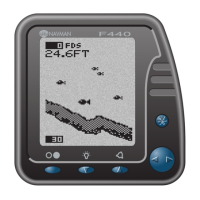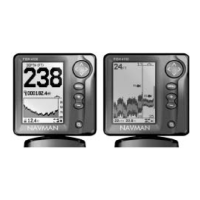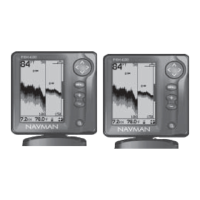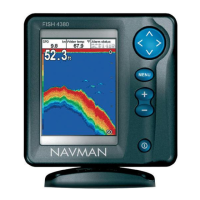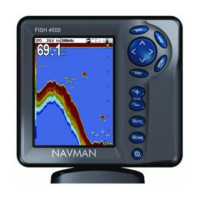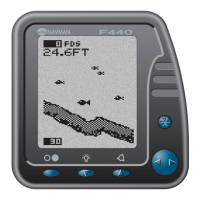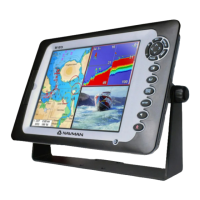Do you have a question about the Navman Fish 4430 and is the answer not in the manual?
Details the fishfinder's capabilities, including depth, voltage, and temperature measurement.
Explains how the fishfinder can aid in navigation by identifying bottom features.
Provides tips on using the fishfinder to locate fish and underwater features.
Instructions for connecting the unit's power cable and transducer.
Navigating the primary menu interface to access different functions.
Instructions for using the built-in simulator for practice.
How to adjust the screen brightness for optimal visibility.
Displaying historical sonar data over time with recent events on the right.
Magnifying specific areas of sonar data for closer inspection.
Detailed sonar echo display showing echo strength and depth.
Displaying navigation-related data like depth and speed.
Showing various sensor readings including temperature and battery voltage.
Accessing the device's configuration options.
Accessing options to adjust the depth display range.
Detailed usage instructions for the history display screen.
Explains how alarms automatically reactivate after conditions change.
How to enable alarms and adjust their trigger values.
How fish targets are identified and represented on the screen.
Guidance on understanding the information presented on the history screen.
Explains how fish appear as arches on the sonar display.
Explains how signal strength is indicated by shading on the display.
Describes areas where the sonar beam cannot 'see' due to obstructions.
How the screen dynamically updates as the boat moves.
Describes the screen output when the boat is stationary.
Detailed operation of the zoom screen for detailed views.
How to keep the bottom fixed in the zoom display.
Instructions for changing the zoom level for magnification.
Detailed operation and interpretation of the sonar screen.
Identifying different bottom compositions from sonar returns.
Identifying fish based on echo strength and return patterns.
Customizing echo display intensity using the shading bar.
Adjusting sonar sensitivity manually for optimal detail.
Detailed operation of the navigate screen for speed and depth.
Selecting units for water depth measurement (feet, fathoms, meters).
Selecting units for boat speed measurement (knots, MPH, KPH).
Displaying temperature, battery voltage, speed, and depth.
Using trip and total distance logs on the FISH 4431 model.
Setting speed units for the FISH 4431 model.
Adjusting the depth display range settings.
Selecting between automatic and manual depth range modes.
Choosing specific pre-selected water depths in manual mode.
Setting up and customizing alarm triggers and behaviors.
Selecting display units for depth, temperature, speed, and fuel.
Choosing how fish targets are represented on the screen.
Adjusting the screen contrast level for better readability.
Configuring the split zoom display mode.
Configuring distance logs for the FISH 4431 model.
Setting language, keel offset, and sensor calibration.
Calibrating temperature, fish filter, and speed sensors.
Restoring all unit settings to their original factory defaults.
Understanding the various alarm symbols and their beeper cycles.
Behavior of alarms that automatically reactivate after conditions change.
Steps to enable alarms and adjust their trigger values.
Selecting temperature units between Fahrenheit (°F) and Celsius (°C).
Selecting speed units among knots, MPH, or KPH.
Options for displaying fish symbols on the screen.
Choosing how fish targets are represented with different symbols.
Adjusting the screen contrast level for better visibility.
Setting the screen contrast level between 0 and 16.
Configuring the split zoom display mode.
Enabling or disabling the split zoom / history screen.
Configuring and resetting distance logs for the FISH 4431 model.
Resetting the trip log counter to zero.
Resetting both trip and total log data to zero.
Setting language, keel offset, and calibrating sensors.
Choosing the display language for the unit.
Compensating depth readings based on transducer position.
Adjusting the water temperature measurement for accuracy.
Fine-tuning the fish detection sensitivity.
Adjusting speed and log readings for the FISH 4431 model.
Steps to reset all unit settings to their original factory defaults.
General information on the importance of correct installation.
List of items included in the standard FISH 4430/4431 package.
Details on optional transducers and accessories available.
Methods for physically installing the display unit on a boat.
Explains basic and auto-power wiring configurations.
Interfacing the fishfinder with other NMEA-compatible marine instruments.
Comprehensive technical specifications for the fishfinder.
Steps to resolve issues when the fishfinder does not turn on.
Steps to resolve issues when the fishfinder cannot be powered off.
Diagnosing and fixing inconsistent or erratic performance.
Resolving issues where the bottom is not detected or displayed.
Correcting problems with the bottom display appearing too high.
Troubleshooting issues with echo signals while the boat is moving.
Diagnosing audio alerts without any visual output on the screen.
Steps to fix display issues related to incorrect language settings.
| Brand | Navman |
|---|---|
| Model | Fish 4430 |
| Category | Fish Finder |
| Language | English |


